Congress Wants More Veterans Hired for Federal Jobs
The number of veterans in the federal workforce is in decline, according to a new Office of Personnel Management report highlighted in today’s WaPo.
The 55-page report, released last week, details federal agencies’ outreach efforts in fiscal 2004, the most recent year for which data are available. The report notes, for instance, that veterans accounted for 33.6 percent of new full-time permanent federal hires in 2004, a 0.6 percent increase from 2003.
Overall, the government employed 453,793 veterans that year, making them 25.1 percent of the 1.8 million-strong federal civilian workforce. More than half of all veterans in the government — about 51 percent, or 231,171 people — worked in the Defense Department.
The long-term trend, however, shows a gradual decline. In 1994, 558,347 veterans made up 28 percent of the federal workforce. Since 2000, the number has never reached 26 percent. In fact, the raw number of veterans in the government fell in eight of the 10 years since 1995 . (Veterans do better in government than in the private sector, where they made up 9.4 percent of the workforce in 2003.)
This decline is cause for concern for some government leaders:
Such figures have led some members of Congress to conclude that agencies must do more. The topic is especially sensitive these days as thousands of military members, some of them seriously injured, return from service in Iraq and Afghanistan and look for new work.”While some agencies perform better than others in the practice of employing and re-employing veterans, . . . overall improvement is needed,” said Rep. Lane Evans (Ill.), the ranking Democrat on the House Committee on Veterans Affairs. “I would like to see a robust employment-outreach effort by the administration to service members, veterans and military families.”
Administration officials have said that such efforts are already underway. Agencies have sought out veterans at job fairs, through recruiting visits to medical centers and military bases, and through training for managers. “The federal government recently has made a major effort to recruit more veterans,” said Joseph Sharpe, deputy director for economics at the American Legion. “I do foresee an increase in veterans working for the federal government.”
As a veteran, I am glad to see outreach to those who have served in the armed forces. As a taxpayer, too, I am glad to see the government recognize that training already invested for uniformed personnel may translate well into civilian service with the government.
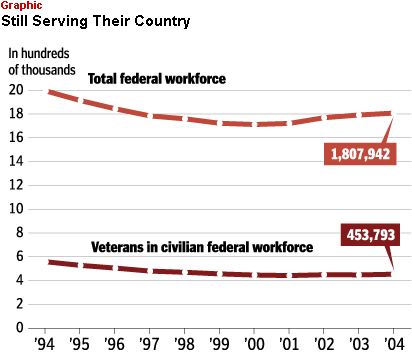 As a social scientist, however, I would prefer to see these data in context. Without raw data, it is hard to do this. I could not find the report referenced in the story (or anything from 2006) on the OPM web site. I have e-mailed asking for a copy. In the meantime, though, I would think that there are several innocent explanations for the decline in veteran hiring.
As a social scientist, however, I would prefer to see these data in context. Without raw data, it is hard to do this. I could not find the report referenced in the story (or anything from 2006) on the OPM web site. I have e-mailed asking for a copy. In the meantime, though, I would think that there are several innocent explanations for the decline in veteran hiring.
Most obviously, there has been a decline in the number of veterans in the general population. After all, military service was compulsory until the abolution of the draft in 1973 and the armed forces got significantly smaller after the end of the Cold War in the early 1990s. According to the Census Bureau, there were 26.4 million veterans in 2000, or roughly 13 percent of the then-population of 281.4 million. Of these, only 6 percent were women and a whopping 37 percent were over the age of 65. Further, only 54.7 percent of them were employed.
This is, to say the least, not an ideal pool from which to attempt to hire new workers. The number of employed veterans comprise only 7.1% of the population. And this percentage skews incredibly male. OPM has been trying to hire women, especially in underrepresented agencies like the Defense Department–the most likely place where male veterans will find their skill set marketable–for decades. So, in essence, the goals of hiring more women and more veterans are at cross purposes.
Update: Also, the fact that civilian hiring has increased since 9/11, during a time when many people would ordinarily be leaving the military are unable to do so, would likely contribute to the problem.
Update 2: OPM responded to my request in short order: ANNUAL REPORT TO THE CONGRESS: THE EMPLOYMENT OF VETERANS IN THE FEDERAL GOVERNMENT FY 2004 [PDF].
A cursory read-through of the report reveals no consideration of the comparative data discussed above. Interestingly, though, it does not give the impression one gets from reading the WaPo story. Indeed, the hiring of veterans is actually up slightly:
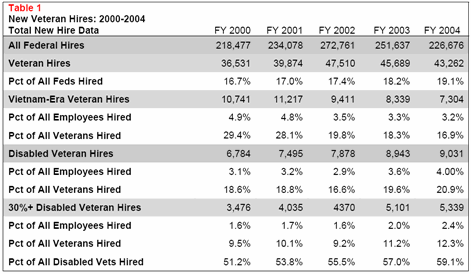
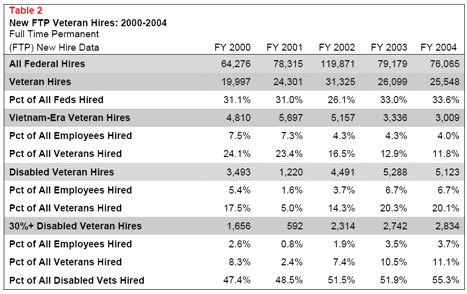
During FY 2004, there were 54,229 retirements from the Federal workforce. Veterans represented 22,148 (40.8 percent) of those employees retiring.
[…]
In Federal employment, veterans averaged 50.31 years of age as compared to 46.85 years for all Federal employees. The median age for all veterans was 59 years, while the median age for female veterans was 45 years. Veterans age 65 years and older accounted for 38.5 percent of the overall veteran population. This was a 0.8 percent increase from the 36.7 percent reported as the average age in the FY 2003 report.
This is hardly problematic, however. Hiring fewer veterans when there are fewer veterans to higher is not discrimination–it’s basic math.
Update 3: I am reminded of an old Dilbert strip (4/17/96) when the Pointy Headed Boss, informed that “40% of all sick days taken by your staff are Fridays and Mondays!” exclaims, “What kind of idiot do they think I am?”
The reply: “Not an idiot savant. They can do math.”
OTB roving correspondent Richard Gardner contributed to this report.

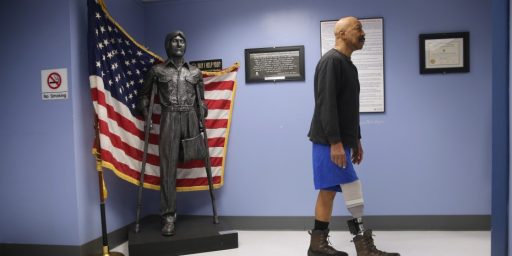
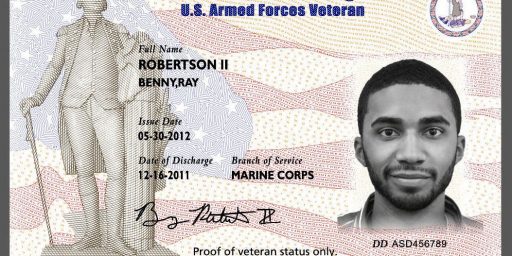


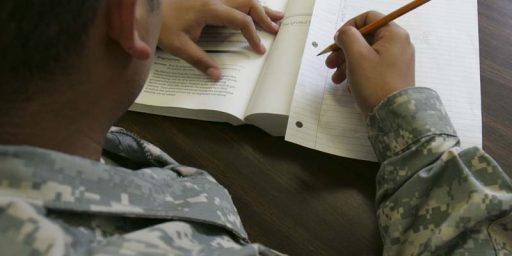
Great, ANOTHER affirmative action program. Give me a break! Whatever happened to hiring people based on merit. The last thing we need is a federal bureaucracy populated by a bunch of shell-shocked vets with no experience. It figures that a liberal like Lane Evans would be pushing for this sort of thing.
Perhaps I fail to ‘get’ the sarcasm?
Civilians HAVE jobs at all simply because of the sacrifices made by Veterans. They have civilian jobs, and not compulsory military jobs, because of those who have volunteered for the duty.